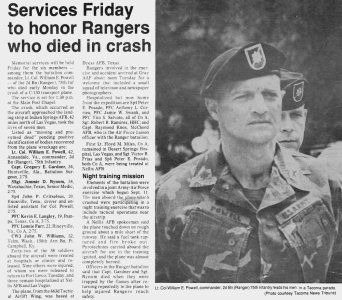I have the investigation paperwork from this crash. In the interests of history, since it involves Special Operations, I'm going to post some of the details of those documents here. I am not posting names. (
@Ooh-Rah this is unclassified material. I'll leave it up to you to decide if it belongs in the Ranger, 160th SOAR or History threads etc.)
History of Flight/Narrative, Findings, crash of C-130H tail #74-1672, 21 September, 1981.
This was a Tactical Assault SOLL II landing [Special Operations Low Level] involving an Airborne Radar Approach to Indian Springs Air Force Auxillary Field, Nevada in support of a Joint Training Exercise.
The aircraft, callsign "SING 35" departed Fairchild AFB, Washington, at 0338Z as number five in a two minutes intrail formation. The flight was to terminate with an airborne radar approach to Indian Springs AFAF with the pilot using night vision goggles for landing zone acquisition and landing. The high and low portions of the mission to the pre-initial point [PIP] were uneventful. Descent was initiated at approximately five miles to go at an initial rate of 1500 FPM to intercept the planned glide path from above. The descent rate was decreased to 800-1000 FPM just prior to the pilot in the right seat transferring control of the aircraft to the pilot in the left seat.
The aircraft touched down 5360 feet short of runway 08, nose gear first, left main gear, right main gear. The aircraft became airborne again and then touched down a second time, nose gear first, right main gear, left main gear. The nose gear was damaged on initial impact and failed on the second impact. The aircraft slid forward on its nose gear and main gear, making a slight left correction, then entered a left yaw, right skid, failing its main gear. As the aircraft came to a stop the right wing impacted the ground and the number three and four propellers separated. The aircraft came to a rest 1555 feet from initial touchdown, 114 degrees to the left of runway heading. The aircraft caught fire on the outboard section of the right wing and became enveloped in fire and exploded approximately 17 minutes after touchdown.
Prior to explosion, ten crew members and 51 US Army personnel egressed the aircraft. Seven passengers were fatalities. The aircraft was destroyed by post-mishap fire and explosion.
Causes:
--The aircraft commander and co-pilot were wearing night vision goggles which restrict field of vision and depth perception and did not have visual cues to see the ground.
--The initial training program was deficient in the safety pilot's responsibilities and the use, capabilities and limitations of NVGs.
--The aircrew failed to update or calibrate their pressure altimeter for the approach, so the aircraft was 110 to 190 feet lower than indicated.
--The transfer of aircraft control at a critical phase of the approach exceeded the pilot's capability and proficiency.
--The aircrew was not proficient in SOLL II operations.
--Supervisors did not ensure the aircrew was proficient in SOLL II operations.
--Aircrew failed to give one minute brace-for-impact warning.

